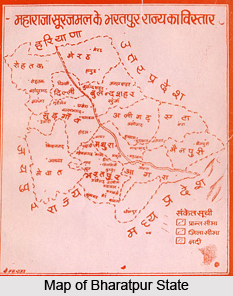 Baldeo Singh was the ruler or Maharaja of princely state of Bharatpur, which was founded by Maharaja Suraj Mal in the year 1733. At present it is located in the Brij region in the state of Rajasthan. The princely state of Bharatpur belonged to the Rajputana Agency. He was ruled over the territory from the year 1823 to 1825. The Maharaja of the princely state belonged to the Sinsiniwar Jat dynasty and was born in a Jat family. Baldeo Singh succeeded his brother Maharaja Randhir Singh of Bharatpur after his death in the year 1823 and ascended the royal throne. As per rule, since the preceding ruler, Maharaja Randhir Singh, had no son, Baldeo Singh ascended the throne and became the Maharaja of princely state of Bharatpur.
Baldeo Singh was the ruler or Maharaja of princely state of Bharatpur, which was founded by Maharaja Suraj Mal in the year 1733. At present it is located in the Brij region in the state of Rajasthan. The princely state of Bharatpur belonged to the Rajputana Agency. He was ruled over the territory from the year 1823 to 1825. The Maharaja of the princely state belonged to the Sinsiniwar Jat dynasty and was born in a Jat family. Baldeo Singh succeeded his brother Maharaja Randhir Singh of Bharatpur after his death in the year 1823 and ascended the royal throne. As per rule, since the preceding ruler, Maharaja Randhir Singh, had no son, Baldeo Singh ascended the throne and became the Maharaja of princely state of Bharatpur.
Rule of Baldeo Singh
Due to the succession of Baldeo Singh, various family disputes took place. The wife of Maharaja Randhir Singh, Maharani Laxmi, was unhappy with the ascension of Baldeo Singh. Later she moved to Vrindavan and soon afterwards, Maharani Laxmi died. Moreover, Madho Singh and Durjansal, the cons of his younger brother, revolted against the Maharaja of princely state of Bharatpur. In order to bring the situation in control, Baldeo Singh took the support of the resident of the British East India Company at Delhi named Sir David Ochterlony. Balwant Singh, his son, was made the successor in the presence of the British resident.
Maharaja Baldeo Singh of Bharatpur died on 26 February 1825 and the endorsement of Sir David Ochterlony of his succession was disclaimed and he was replaced by Lord Amherest, who was the Governor General of British India. Eventually a conflict occurred between Madho Singh and Durjansal; and the former moved to Deeg and began to arrange a military force. The dispute was intervened by the new resident at Delhi, Charles Metcalf. Moreover he sent forces of the British East India Company to attack and capture the Bharatpur fortress. Lord Combermere led the British army and reached the princely state of Bharatpur on 10th December 1825.a war commenced on 23rd December 1825 and the British Indian army seized the fort of Bharatpur. Later the British administration reigned over Rajputana.
Maharaja Baldeo Singh of Bharatpur died on 26th February 1825 and was succeeded by Maharaja Balwant Singh, who was his son.



















